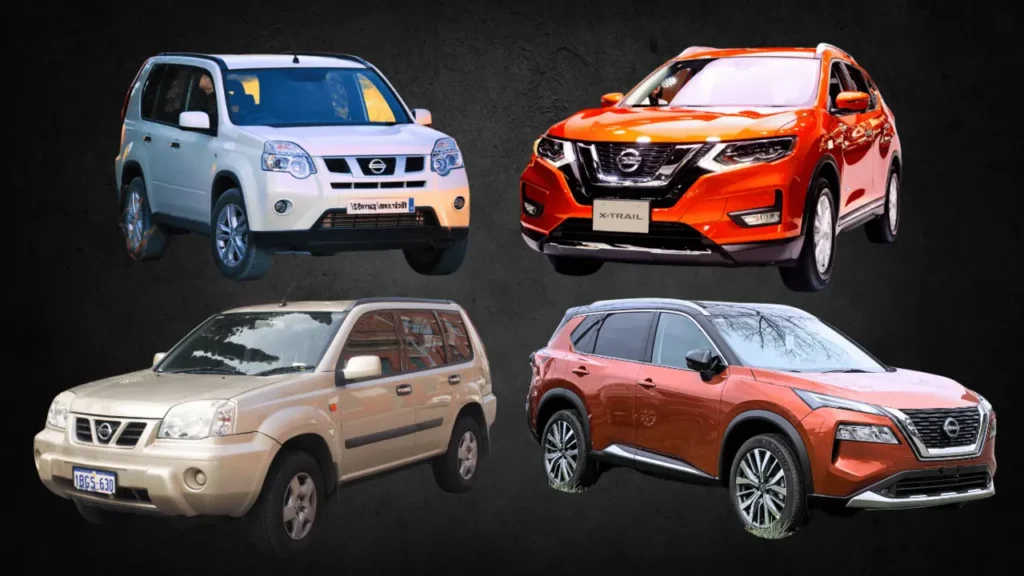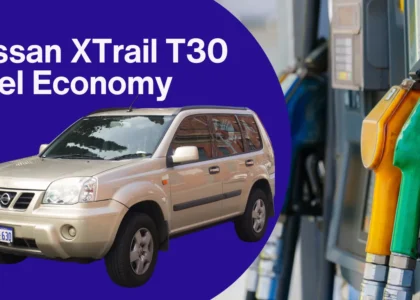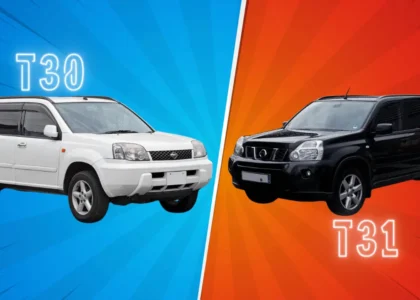The Origins and Evolution of the Nissan Xtrail
Introduction to the Nissan Xtrail
Ever wondered how a legendary SUV is born? The Nissan X-Trail’s story is one of innovation, vision, and adventure.
Let’s dive into the fascinating origins of this beloved vehicle:
• Concept: A versatile SUV designed for both city streets and rugged terrain
• Origin: Born from Nissan’s commitment to blending comfort with capability
• Uniqueness: Pioneering features that set it apart in a crowded market
Whether you’re a die-hard Nissan fan, a curious car enthusiast, or an automotive history buff, the XTrail’s journey from concept to reality is sure to captivate you.
Chronology of Nissan XTrail Generations
The Nissan X-Trail has undergone a remarkable evolution across four generations, each introducing significant enhancements and innovations. Here’s a chronological overview of the key changes and developments in this popular compact crossover SUV:
First Generation (T30) – Key Features and Innovations

The introduction of the first-generation Nissan X-Trail (T30) to the UK market in August 2001 marked Nissan’s inaugural venture into the SUV segment. This model combined performance, reliability, and affordability, offering buyers a choice between a 2.0-litre petrol engine producing 146PS and a 2.2-litre diesel unit with 136PS. The diesel variant emphasized efficiency, torque, and towing capacity, catering to those prioritizing fuel economy.
One standout feature of the T30 was its reputation for durability and ruggedness, making it a favored choice among UK buyers seeking a dependable and practical SUV. While it may have lacked some refinements compared to competitors, its affordability and robust capability positioned it as an economical yet robust SUV option.
Second Generation (T31) – Market Expansion and Upgrades

The second-generation Nissan X-Trail (T31), introduced in the UK in 2007 and remaining in the market until 2014, represented a substantial leap forward in design, performance, and versatility.
- Expanded Interior Comfort: The T31 boasted a more spacious and comfortable interior, offering increased legroom and headroom for front and rear passengers, elevating the overall driving experience.
- Diverse Engine Options: Buyers could now choose from a 2.0-litre petrol, a 2.5-litre petrol, and two diesel options: a 2.0-litre and a 2.2-litre, catering to different driving preferences.
- Enhanced Off-Road Capability: With an improved all-wheel-drive system and higher ground clearance, the T31 showcased superior off-road capabilities while maintaining practicality for everyday use.
- Modern Exterior Design: The T31 featured a more contemporary and stylish exterior design, reflecting Nissan’s commitment to evolving aesthetics and keeping pace with current automotive trends.
Third Generation (T32) – Technological Advancements

Arriving in the UK in 2014 and remaining in the market until 2022, the third-generation Nissan X-Trail (T32) continued the legacy of its predecessors, bringing forth a new era of innovation and refinement.
- Advanced Technology Integration: The T32 X-Trail introduced cutting-edge technologies, including advanced driver-assistance features, infotainment systems, and connectivity options, elevating the driving experience.
- Flexible Seating Configuration: One of the standout features was its versatile seating arrangement, with the option for a third row accommodating up to seven passengers, making it an ideal choice for larger families.
- Enhanced Safety Features: The T32 X-Trail was equipped with an array of safety enhancements, including intelligent emergency braking, lane-keeping assist, and blind-spot monitoring, providing higher protection for drivers and passengers.
- Sleeker Exterior Design: The T32 boasted a refreshed and more streamlined exterior design, with sculpted lines and an aerodynamic profile enhancing its visual appeal and contributing to improved fuel efficiency and overall performance.
Fourth Generation (T33) – Modern Innovations

The latest fourth-generation Nissan X-Trail (T33), making its debut in the UK market in 2022 and currently available, represents a significant evolution in the X-Trail lineage.
- Electrified Powertrains: One of the standout features is its commitment to sustainability, offering a range of electrified powertrains, including hybrid and electric options, catering to the growing demand for eco-friendly vehicles in the UK market.
- Enhanced Interior Comfort: Building upon the success of its predecessor, the T33 model offers an even more comfortable and spacious interior, with improved legroom and headroom for passengers, ensuring a premium driving experience.
- Cutting-Edge Infotainment: The T33 X-Trail incorporates the latest infotainment systems and connectivity options, enhancing the driving experience with intuitive controls, crisp displays, and seamless smartphone integration.
- Advanced Safety Technologies: Equipped with state-of-the-art driver-assistance technology, features like adaptive cruise control, lane departure warning, and automatic emergency braking work seamlessly together to elevate safety standards for all occupants.
- Sleek and Dynamic Design: The T33 model boasts a contemporary exterior design with sleek lines and a dynamic profile, not only enhancing its visual appeal but also contributing to improved aerodynamics and fuel efficiency.
Engine Types and Variants
The Nissan X-Trail has offered a diverse range of engine options across its generations, catering to different driving preferences and market demands. These engine types and variants can be broadly categorized into three main categories:
Gasoline Engines – Variants and Performance
- 1.5T/150kW Hybrid: This 1.5-liter turbocharged three-cylinder gasoline engine is found in the latest fourth-generation X-Trail models. It produces 150kW (201 hp) and is paired with an electric motor, delivering a combined output of 307kW (412 hp) and 330Nm of torque.
- 2.5-liter QR25DE: Offered in earlier generations, this four-cylinder gasoline engine initially produced 132kW (177 hp) in the Australian market and was later detuned to 123kW (169 hp).
- 2.0-liter QR20DE: Another four-cylinder gasoline option, this engine produced either 103kW (140 hp) or 110kW (150 hp), depending on the transmission choice (manual or automatic).
- SR20VET: Exclusive to the Japanese market, this turbocharged 2.0-liter gasoline engine delivers an impressive 206kW (276 hp) and is found in the high-performance X-Trail GT variant.
These gasoline engines have offered varying levels of performance, ranging from the fuel-efficient 1.5-liter hybrid to the powerful turbocharged SR20VET, catering to different driving preferences and market demands.
Diesel Engines – Features and Advantages
- 2.2-liter YD22DDTi: This turbocharged common-rail diesel engine was a popular choice in the United Kingdom, known for its impressive torque and fuel efficiency.
- 2.0-liter dCi (M9R): Developed jointly with Renault, this 2.0-liter turbocharged common-rail diesel engine was offered in two power outputs: 150 PS (110 kW; 148 hp) and 177 PS (130 kW; 175 hp).
Diesel engines have been favored for their exceptional fuel economy and torque delivery, making them ideal for those seeking a balance between performance and efficiency, particularly in markets where diesel vehicles are popular.
Hybrid Models – Technological Developments
The latest fourth-generation Nissan X-Trail has embraced hybrid technology, offering two distinct hybrid powertrain options:
- e-Power: This innovative system utilizes the 1.5-liter VC-Turbo three-cylinder gasoline engine as a generator to charge a lithium-ion battery, which in turn powers an electric motor that drives the wheels. The e-Power system provides a smooth, electric vehicle-like driving experience while offering improved fuel efficiency and reduced emissions.
- e-4orce: Building upon the e-Power setup, the e-4orce variant adds an additional electric motor to power the rear wheels, effectively making it an all-wheel-drive system. This configuration offers enhanced traction and acceleration while maintaining the benefits of the e-Power system.
The hybrid models represent Nissan’s commitment to sustainability and technological advancements, offering a unique driving experience while prioritizing fuel efficiency and reduced environmental impact.
Nissan XTrail in Different Markets
The Nissan X-Trail has garnered widespread popularity across various markets worldwide, catering to diverse consumer preferences and regional demands. Here’s an overview of its presence in different regions:
Asia
The X-Trail has enjoyed significant success in Asian markets, particularly in Japan, where it is known as the Nissan X-Trail. The fourth-generation model, introduced in 2021, marked a significant shift by abandoning turbo-diesel engines and introducing an e-Power series hybrid option, becoming the sole powertrain choice in Japan. This move aligns with the growing demand for electrified vehicles and reflects Nissan’s commitment to sustainability in the Japanese market.
Europe
In Europe, the X-Trail has established itself as a popular choice among compact crossover SUV buyers. The fourth-generation model, introduced in 2022, also features the e-Power series hybrid option, catering to the increasing demand for eco-friendly vehicles in the region. Additionally, the X-Trail’s sleek and modern design, coupled with its versatility and advanced safety features, has contributed to its appeal among European consumers.
North America
In the North American market, the X-Trail is known as the Nissan Rogue. The fourth-generation model, introduced in 2022, features a smaller 1.5L turbocharged three-cylinder engine, delivering better power and torque outputs compared to its predecessor. This engine choice aligns with the market’s preferences for fuel efficiency and performance. The Rogue’s spacious interior, advanced technology, and safety features have made it a popular choice among families and urban dwellers alike.
Australia
Australia is among the top markets globally for the Nissan X-Trail, reflecting its enduring popularity in the region. Recognizing the surging demand for electrified vehicles, including the top-selling Toyota RAV4 Hybrid, Nissan Australia recently introduced an e-Power series hybrid option for the X-Trail. This move aims to capitalize on the growing eco-conscious consumer segment while maintaining the X-Trail’s reputation for reliability and versatility in the Australian market.
Conclusion
The Nissan X-Trail has undergone a remarkable journey, evolving from a rugged and affordable SUV to a sleek and technologically advanced crossover. Its ability to adapt to changing consumer preferences, regional demands, and environmental concerns has been the driving force behind its enduring success across multiple generations and markets. As the world moves towards a more sustainable future, the X-Trail’s embrace of hybrid and electrified powertrains demonstrates Nissan’s commitment to innovation and environmental responsibility.
While the X-Trail’s journey has been characterized by continuous improvement and adaptation, its core values of versatility, reliability, and practicality have remained constant. Whether tackling urban landscapes or venturing off the beaten path, the X-Trail continues to cater to a diverse range of driving needs, making it a trusted companion for adventures of all kinds. As Nissan looks to the future, the X-Trail stands poised to continue its evolution, cementing its legacy as a trailblazer in the compact crossover SUV segment.






One thought on “Nissan Xtrail Through the Ages: Key Changes and Developments”